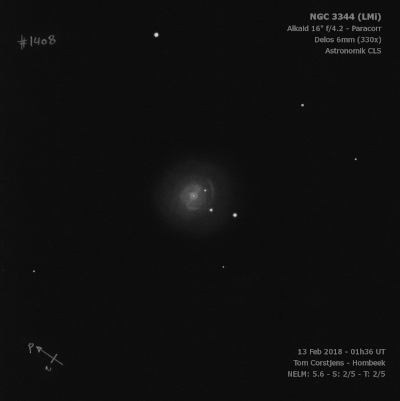
William Herschel discovered NGC 3344 = H I-81 = h739 on 6 Apr 1785 (sweep 393) and recorded "cB, cL, milky, very near and preceding 2 stars; a small part of the nebula is considerably brighter than the rest; the 2 stars and the brightest part of the nebula are all within 2' and nearly in one parallel. The greatest part of the milkiness is preceding the bright part, and the termination of it is imperceptible." He published a sketch in his 1811 paper (Fig. 2) as an illustration of "Nebulosities joined to Nebulae."
On 19 Feb 1827 (sweep 58), John Herschel logged, "pB; L; gbM; has (?) a star excentric within it and a double star closely following it." Bindon Stoney, observing on 3 Mar 1851, called it a "spiral, vF, has a branch from p edge round to n and f."
200/250mm - 8" (3/28/81): faint, large, low surface brightness. Two mag 10 stars are at the east edge.
400/500mm - 17.5" (1/19/91): fairly bright, large, about 4'x3' extended ~E-W. Unusual appearance as two bright stars are involved on the east side. Sharply concentrated with a faint outer halo and a well-defined much brighter core. A mag 10.5 star is on the east side 52" from the center and a mag 10 star is at the east edge of the halo 1.6' from the center. Also a mag 13.5 star is superimposed about 30" SSE of the core.
Notes by Steve Gottlieb